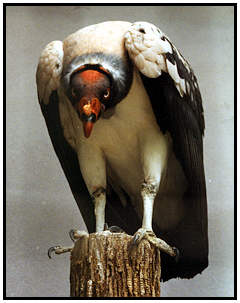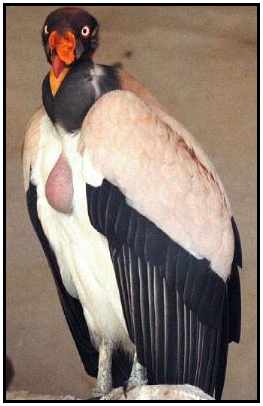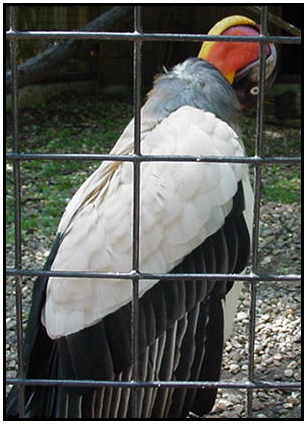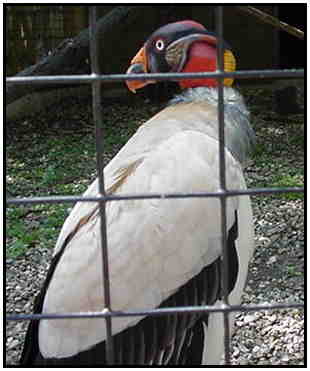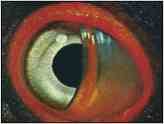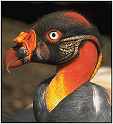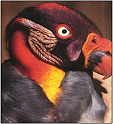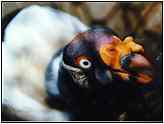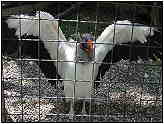KingOrder: Falconiformes. Family: Cathartidae. (New World vulture). Scientific Name: Sarcoramphus papa. (Historic name: Sarcorhamphus papa. Translation: 'Father of the Coffin') Common Names: King Vulture or King Jan Kro. Conservation Status: Rare. Although King Vultures are not yet listed as endangered or threatened, there has been a substantial decrease in wild populations largely due to habitat destruction.
King Vulture (Photograph Courtesy of Lisa Purcell Copyright ©2000)Rescue & Recovery: To offset the reduction in wild numbers a captive breeding programme is in operation, with the studbook for this being located at the Sequoia Park Zoo. Details recorded include dates hatched, parentage, locations, wild or captive born and dates of death; the earliest entry dates back to 1900. King Vultures are a protected bird in Belize. Geographical Range: Mexico and Venezuela, through to Argentina, where they are sometimes seen soaring in flocks over rain forest areas.
King Vulture (Copyright ©2000)Habitat: Wooded lowlands and tropical rain forests. Physical
Characteristics: A quite distinctive bird, able to be easily recognised.
The King Vulture grows to about 80 centimetres long and may get
to a weight of 3.7 kgs making it the largest New World vulture (excluding
the condors). The wings are short and quite broad and from the neck
down the birds are an overall white with a black band running along
the rear edge of the wings. A small collar of feathers at the base
of the neck is blackish gray while the bare skin on the head and
neck is garish colourings of orange, green, yellow and purplish
blue. The crown is covered with small bristle-like feathers and
a fleshy wattle directly above the nostrils. King Vultures do not
tolerate cold conditions well and they suffer badly from frostbite.
There have been birds lose toes to this condition, a situation which
almost inevitably results in euthanasia.
Differences between male and female birds are very slight and surgical
work is usually required to sex birds.
King Vulture (Photograph Courtesy of Holly Dean Morris Copyright ©2000)Food: The King Vulture has a particularly large strong beak which it uses to tear apart carrion. As this is difficult to spot in dense bush the King Vulture relies heavily on its sense of smell to find food. It is often one of the first birds on the scene which is able to tear through a strong hide and commence eating. Diet seems to consist mostly of carrion though there have been occasional reports of it killing live animals. Stranded fish on river banks are another addition to the menu. There have been reports of the King Vulture killing calves or reptiles, but these are unsupported by solid evidence. In zoos birds of prey like this are fed on mice, mealworms and prepared bird of prey diets.
King Vulture (Photograph Courtesy of Holly Dean Morris Copyright ©2000)Reproduction: In depth studies of this bird have yet to be done as so not much is known about the breeding habits of the King Vulture. In fact, not until November 1998 was this bird successfully photographed nesting in the wild. We know King Vultures nest in trees, often very high up and may also nest in rocky areas, or tree stumps. Normally one egg is produced although pairs have been seen to produce up to three eggs in a season when chicks have been lost. The incubation period 56-58 days with both parents sharing in the task. The chicks are born pure black and remain this colour for the first three years, before turning grey then white at around five to seven years (sexual maturity). King Vultures become sensitive when nesting and any upset may cause the birds to kill the hatchling. During the same period they are highly aggressive and hand-raised birds, having no fear of humans, may be particularly dangerous. Thumbnails (Click For Full-Size Image):
|

